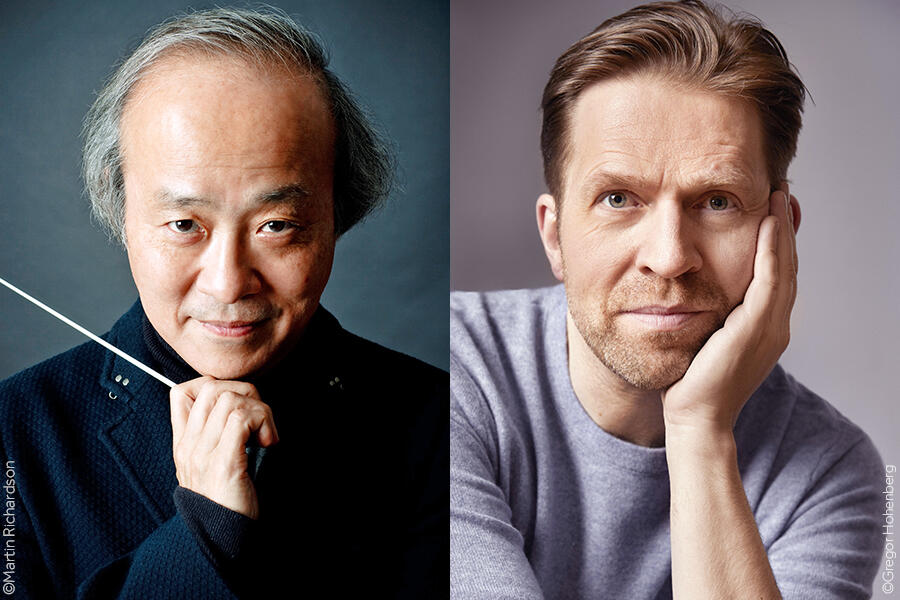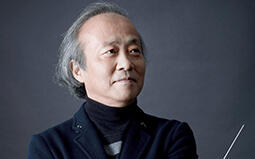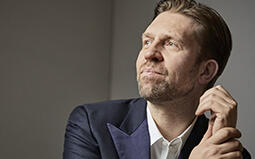- Home
- Concerts
- Subscription Concerts 2023-2024
- Program B
- No. 1994 Subscription (Program B)
No. 1994 Subscription (Program B)
Suntory Hall
Google Map Seating Chart

Program
Beethoven / Piano Concerto No. 5 E-flat Major Op. 73, Emperor
Among many historic concerts left on record, the one held on December 22nd, 1808 in Vienna is significant by far, for the audience witnessed the world premieres of Beethoven’s Symphonies No. 5 (Destiny) and No. 6 (Pastorale) besides the first Viennese performance of his Piano Concerto No. 4 with him as soloist. He set to work on the next Piano Concerto No. 5 around the end of this December of great importance, to complete it by the summer of 1809.
No. 5 is Beethoven’s only piano concerto for which he couldn’t serve as soloist at the premiere, as his hearing was deteriorated seriously by then. Presumably because of that, he subsequently never wrote a new concerto for his instrument. This circumstance is related to the absence in No. 5 of traditional cadenza (where a soloist improvises freely without the orchestra, towards the end of the sonata movement). The cautious composer writes out all the cadential passages and reminds soloists on the score not to add any cadenza of their own.
No. 5 has an astounding, unheard-of beginning for a concerto: the soloist, backed up by the orchestra, gives a brilliant cadenza-like highlight before even the main sonata starts. The middle movement, a sublime variation, is followed seamlessly by the frisky last movement in rondo sonata form. Towards the closing, the serene duet between timpani and piano leads to the majestic conclusion worthy of the byname Emperor, although the appellation didn’t originate with Beethoven.
[Kumiko Nishi]
Brahms / Symphony No. 3 F Major Op. 90
Feeling the shadow of the awe-inspiring giant Beethoven, Brahms spent over twenty years to complete his first symphony. In contrast, No. 3 was written speedily in the summer of 1883 in the scenic summer-resort Wiesbaden, Germany. It is the shortest of his all four symphonies and, moreover, each of the four movements ends tranquilly. That is arguably the reason why No. 3 is less frequently programmed for concert than the other three, in spite of its wide popularity (especially because of the third movement) and evaluation it has enjoyed. Incidentally, just before the resounding success of its 1883 premiere in Vienna, his admirer and friend Dvořák was deeply impressed by it and committed himself to writing a work on par with it. And hence, the Czech composer’s Symphony No. 7 exists today.
No. 3 begins with three forceful, broad chords stating a motto (brief motif) which will occur repeatedly throughout the symphony. The motto composed of three notes (F/A-flat/F) is thought to refer to “Frei aber froh” (free but happy). This is Brahms’ life motto responding to “Frei aber einsam” (free but lonely), his friend and violinist Joseph Joachim’s. However, Brahms’ three notes don’t sound “happy” in the context of F major, the symphony’s home key, due to the middle flat note belonging to F minor. It is this tonal ambiguity that brings the work a touch of melancholy.
The relatively transparent scoring instructs during the inner movements for the timpani, trumpets, contrabassoon and two of the horns to be tacit. Furthermore, Brahms breaks the convention by offering the slow third movement (in A–B–A form) with the famous longing melody. This unusual lack of a lively scherzo movement is made up only modestly and momentarily by the dance-like – but still slow – middle section B. The F-minor finale in free sonata form begins softly introducing the wriggling first theme. Then the mood turns bellicose, all at once. The music calms towards the end so the F-major coda recalls the opening movement quietly.
[Kumiko Nishi]
[Encore]
Oct. 26: Brahms / Fantasien Op. 116-6 Intermezzo E major
Oct. 27: Beethoven / Piano Sonata No. 8 C Minor Op. 13 Pathétique - 2nd movement
Piano: Leif Ove Andsnes
Artists
 ConductorTadaaki Otaka*
ConductorTadaaki Otaka*
Tadaaki Otaka studied conducting under the tutelage of Hideo Saito at the Toho Gakuen School of Music, and with Hans Swarowsky atTadaaki Otaka studied conducting under the tutelage of Hideo Saito at the Toho Gakuen School of Music, and with Hans Swarowsky at University of Music and Performing Arts Vienna . He was appointed as Permanent Conductor of the Tokyo Philharmonic Orchestra (now Conductor Laureate), he then continuously served in such positions as Permanent Conductor (now Honorary Guest Conductor) of Yomiuri Nippon Symphony Orchestra, Principal Conductor of the BBC National Orchestra of Wales (now Conductor Laureate), and Artistic Director of the New National Theatre. He has been Music Director of the Osaka Philharmonic Orchestra since 2018. He has also been keen on training the next generation of artists, and he assumed the position of the chairperson of the Panel of Judges of the Tokyo International Music Competition for Conducting in 2021. His first collaboration with the NHK Symphony Orchestra was in 1971 when he conducted the orchestra in a public recording for broadcast, and since then, he has repeatedly returned to the orchestra’s podium, and became the orchestra’s Permanent Conductor in 2010.
 PianoLeif Ove Andsnes
PianoLeif Ove Andsnes
Leif Ove Andsnes was born in the Norwegian city of Karmøy in 1970, and studied with Jiří Hlinka at the Bergen Music Conservatory. With his neat approach to music and simple and fresh sensibility, he has firmly built up his career since the 1990s without being swayed by the trend of the time. He is currently a resident of Bergen. As a pianist, he is also very active in chamber music concerts, while hosting a music festival in his native country. He has been enthusiastic in giving world premiere performances to contemporary works, on the other hand, however, he takes a very cautious approach to selecting his own repertoire, and tries to narrow down programs each season.
In regards to concerto, he has focused on Rakhmaninov since the mid-2000s, and with the NHK Symphony Orchestra, he has performed Piano Concerto No. 2 under the baton of Noseda in 2008, and No. 3 under Blomstedt in 2011. In the 2010s, he focused on Beethoven complete concertos, and in the 2020s, he conducted the Mahler Chamber Orchestra to perform works of Mozart from the keyboard, and planned concert tours and recordings with it. In his first appearance with the NHK Symphony Orchestra, he chose Beethoven, and together performed Beethoven Piano Concerto No. 5 under Charles Dutoit in 1999. On his 5th visit to the orchestra this autumn, which is the first time since November 2016, he will be playing the same work under Herbert Blomstedt, the conductor he has a great trust on. We will surely enjoy hearing further growth and maturity in his performance.
[Takaakira Aosawa, music critic]
* Artists have been changed from initially scheduled Herbert Blomstedt (Conductor).
Download
Ticket
Program B
No. 1994 Subscription (Program B)
Suntory Hall
Google Map
Seating Chart
Single Tickets Release Date
Pre-sales for Subscribers:Thursday, July 27, 2023
*about subscribers
Sale to General Public:Sunday, July 30, 2023
Price
| S | A | B | C | D | |
|---|---|---|---|---|---|
| Ordinary Ticket | 9,800 | 8,400 | 6,700 | 5,400 | 4,400 |
| Youth Ticket | 4,500 | 4,000 | 3,300 | 2,500 | 1,800 |
Seating chart Enlarge Print PDF
*tax included
*Subscribers receive a 10% discount (Available at NHKSO WEB Ticket and N-Kyo Guide)
*For wheelchair-accessible seats, please refer to the N-Kyo Guide
Youth Tickets
Youth Tickets are great options for those of 25 years old and younger
Subscription tickets
Release Date
ANNUAL SUBSCRIPTION TICKETS
Mon., July 17, 2023 10:00am
[For Subscribers: Sun., July 9, 2023 10:00am]
For further information and
subscription application
*Repertoire, conductor, soloists and program order are subject to change without notice.
*Pre-school children are not allowed in the concert hall


